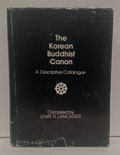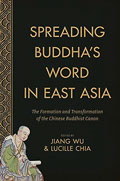start > Klassieke teksten > Late Han tot Tang > tekst
高麗大藏經 Gaoli dazang jing - Korean Tripitaka
Gāolí dàzàng jīng
Engelse titel: Korean Tripitaka
The Tripiṭaka Koreana (goryeo daejanggyeong 高麗大藏經) is a 13th-century canon printed by the Goryeo dynasty in Korea. The original canon was carved in 1087 during a turbulent period in which the Goryeo dynasty was trying to defend its territory from Khitan nomads. The canon was carved in order to gain the necessary merit which might protect Korea from the Khitan.
When the Mongols invaded Korea in 1232, the original set of woodblocks was completely destroyed by fire. In order to ensure protection from the Mongols, King Gojong ordered for the canon to be carved once again. The canon was started in 1236 and was completed in 1251, and took a total of sixteen years to carve.
The original 81,258 woodblocks remain intact today in good condition, and are regarded as accurate and faithful reproductions of the Chinese Buddhist canon. The canonical translations are divided mainly into two literal tripiṭakas: a Mahāyāna Tripiṭaka and a Hīnayāna Tripiṭaka, each containing the three classical divisions of Sūtra, Vinaya, and Abhidharma. (bron Lapis Lazuli
Buswell 2014: Koryo taejanggyong. (高麗大藏經). In Korean, “The Koryo [Dynasty] Scriptures of the Great Repository”; popularly known in Korean as the P’ALMAN TAEJANGGYONG (“The Scriptures of the Great Repository in Eighty Thousand [Xylographs]”); referring specifically to the second of the two xylographic canons produced during the Koryo dynasty (937– 1392) and widely regarded as one of the greatest cultural achievements of the Korean Buddhist tradition. The first Koryo edition of the canon was carved between 1011 and c. 1087 but was destroyed in 1234 during the Mongol invasion of the Korean peninsula. The second edition was carved between 1236 and 1251 and included some 1,514 texts in 6,815 rolls, all carved on 81,258 individual woodblocks, which are still housed today in the Scriptural Repository Hall at the monastery of HAEINSA. This massive project was carried out at royal behest by its general editor SUGI (d.u.) and an army of thousands of scholars and craftsmen. The court supported this project because of the canon’s potential value in serving as an apotropaic talisman, which would prompt the various buddhas, as well as the divinities (DEVA) in the heaven of the thirty-three [divinities] (TRĀYASTRIMŚA), to ward off foreign invaders and bring peace to the kingdom. By protecting Buddhism through a state project to preserve its canonical teachings, therefore, Buddhism would in turn protect the state (viz., “state- protection Buddhism,” K. hoguk pulgyo, C. HUGUO FOJIAO). Sugi left thirty rolls (kwon) of detailed collation notes about the editorial procedures he and his team followed in compiling the new canon, the KORYOGUK SINJO TAÉJANG KYOJONG PYOLLOK (s.v.). Sugi’s notes make clear that the second Koryo. edition followed the Song Kaibao and first Koryo xylographic canons in its style and format but drew its readings in large measure from the Khitan Buddhist canon compiled by the Liao dynasty in the north of China. The xylographs typically include twenty-three lines of fourteen characters a piece, with text carved on both sides of the block. The second Koryo canon is arranged with pride of place given to texts from the MAHĀYĀNA tradition.
Because this second Koryo ̆ canon was renowned throughout East Asia for its scholarly accuracy, it was used as the basis of the modern Japanese TAISHŌ SHINSHŪ DAIZŌKYŌ (“New Edition of the Buddhist Canon Compiled during the Taishō Reign Era”), edited by TAKAKUSU JUNJIRŌ and Watanabe Kaikyoku, published using movable-type printing between 1924 and 1935, which has become the standard reference source for East Asian Buddhist materials. (Buswell 2014 p 442)
Indeling tekst
Hieronder gefit de indeling van Lapis Lazuli.
大乘三藏 Mahāyāna Tripiṭaka
- 大乘經 Mahāyāna Sūtra
-- 般若部 Prajñāpāramitā (1–21)
-- 寶積部 Ratnakūṭa (22–55)
-- 大集部 Mahāsannipāta (56–78)
-- 華嚴部 Avataṃsaka (79–104)
-- 涅槃部 Parinirvāṇa (105–110)
-- 五大部外諸重譯經 Other Major Sūtras (111–387)
-- 單譯經 Minor Sūtras (388–522)
- 大乘律 Mahāyāna Vinaya (523–548)
- 大乘論 Mahāyāna Abhidharma
-- 釋經論 Sūtra Commentaries (549–569)
-- 集義論 Collected Treatises (570–646)
小乘三藏 Hīnayāna Tripiṭaka
- 小乘經 Hīnayāna Sūtra
-- 阿含部 Āgama (647–800)
-- 單譯經 Minor Sūtras (801–888)
- 小乘律 Hīnayāna Vinaya (889–942)
- 小乘論 Hīnayāna Abhidharma (943–978)
賢聖傳記錄 Records of the Noble Ones
- 西土賢聖集 Sages of the West (979–1046)
- 此土撰述 Writings of This Land (1047–1087)
宋續入藏經 Song Period and Later Additions (1088–1498)
Bushwell 2014 geeft de volgende samenvatting:
1. Major Mahāyāna scriptures (K 1–548), beginning with the PRAJÑĀPĀRAMITĀ, followed by the RATNAKŪTASŪTRA, and continuing through all the major Mahāyāna sūtras and sūtra collections, from the AVATAMSAKA to the PARINIRVĀNA, SAMDHINIRMOCANA, and LANKĀVATĀRA
2. Mahāyāna śāstras and scriptural commentaries, beginning with the DAZHIDU LUN (Mahāprajñāpāramitāśāstra) (K 549–646)
3. ĀGAMA collections and “hīnayāna” sūtras (K 647–888)
4. VINAYA materials (K 889–937)
5. ABHIDHARMA texts (K 938–977)
6. AVADĀNA and JĀTAKA tales and miscellaneous materials (K 978–1034)
7. Biographies of individual monks, starting with AŚVAGHOSA, NĀGĀRJUNA, etc. (K 1035–1049)
8. Rosters of numerical lists, scriptural catalogues (K 1050–1064)
9. Travelogues and Biographies of Eminent Monks anthologies (K 1065–1086)
10. Miscellaneous sūtras, DHĀRANĪ scriptures and dhāranī anthologies (K 1087-1242)
11. Other miscellaneous sūtras (K 1243–1496)
12. References, Chan anthologies, and indigenous Korean works (K 1497–1514)
Online informatie:
The Collected Works of Korean Buddhism (UCLA)Wikipedia: Tripitaka Koreana (engels)Unesco worldheritage Haeinsa Temple Janggyeong PanjeonAfbeelding Tripitaka Koreana woodblockThe Korean Buddhist Canon: A Descriptive Catalogue (door Lewis R. Lancaster)Literatuur en vertalingen
Hieronder kunt u een selectie maken van de verschillende publicatievormen en de taal. Ik beperk me tot vier taalgebieden (Nederlands, Engels, Frans en Duits). De meeste literatuur is overigens engelstalig. U kunt bij teksttype ook apart de vertalingen selecteren en U kunt desgewenst ook een specifieke auteur zoeken.
Boeken 1 tot 2 van de 2
Lancaster, Lewis R. & Park, Sung-bae (1979). The Korean Buddhist Canon: A Descriptive Catalogue. University of California Press. *
Gedigitaliseerd door A. Charles Muller 2004
ISBN10: 0520031598
Ook online.
Wu, Jiang & Chia, Lucille, redactie (2016). Spreading Buddhas Word in East Asia: The formation and transformation of the Chinese Buddhist Canon. Columbia University Press. *
Meer informatie...
Boeken 1 tot 2 van de 2


